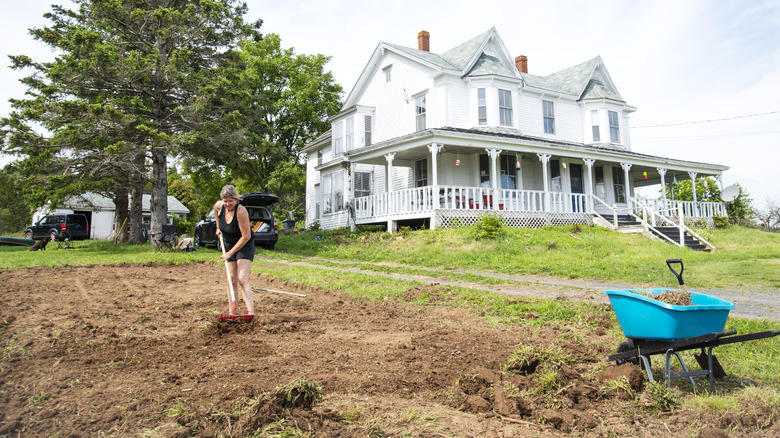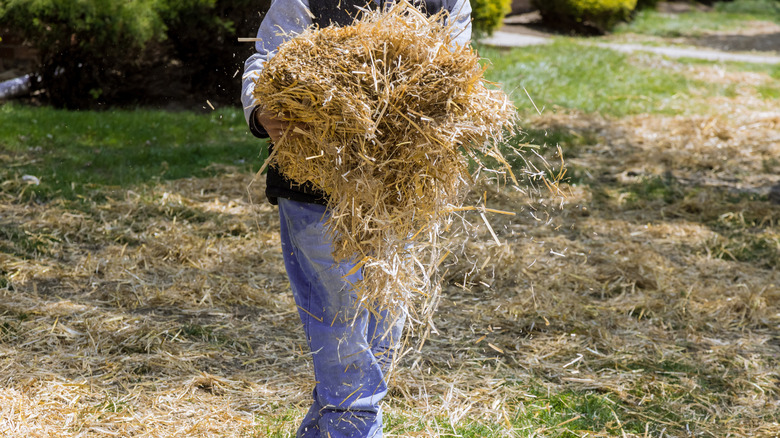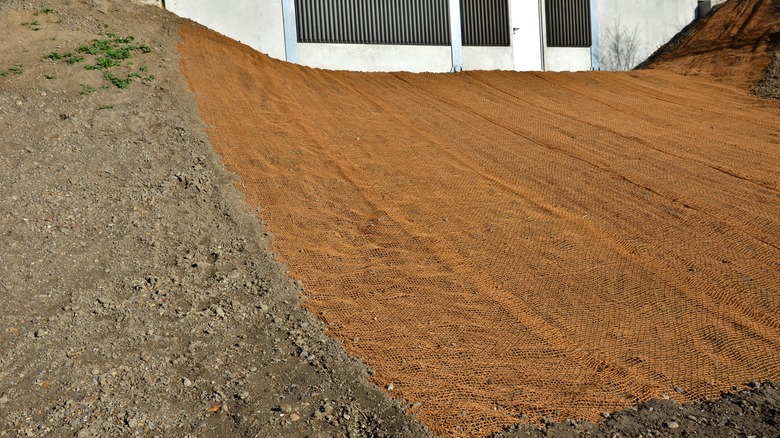Why You Should Be Covering Your Grass Seed With These Materials
Proud of your pristine green backyard expanse? Then you're probably all too familiar with the problems drought, disease, and even insects or moles cause for your lawn — and that's without even mentioning the seed that fails to germinate. But getting grass seed to sprout this spring will be a breeze if you cover your freshly sown lawn with organic matter like topsoil, mulch, or compost until it grows.
The material, sometimes collectively referred to as top-dressing, protects the tiny kernels from weather extremes and hungry critters, ensuring a higher sprout rate. You germinate your vegetable seedlings in dim, damp conditions, so why would grass seed be any different? But while covering grass seed is beneficial in almost every situation, it's a must for homeowners living in dry climates with yards that receive a lot of sunshine.
Covering your seedbed with organic (or inorganic, in a pinch) material can be very beneficial for your future lawn. The biggest plus is that it keeps the soil moist, encouraging more seeds to push their wee green blades out of the ground. It's especially important when sowing a new lawn in the middle of summer. On sloped lawns, mulch keeps the soil and seeds in place during heavy rain or strong winds. Some bird species are also partial to eating grass seeds. If you don't lay down a layer of mulch right after sowing your lawn, you may end up with lots of full-bellied feathered friends and not much grass.
Organic top-dressings for a freshly seeded lawn
Searching online, you'll see that straw is often recommended as a grass seed cover. However, some experts disapprove of its use. Straw is easily confused with hay, which contains weed seeds that will contaminate your lawn. Plus, you need to gather up all the straw once blades of grass start popping up through it. We don't know anyone who needs extra garden tasks! Lay it too thick, and you'll form a barrier against much-needed sunlight, inhibiting grass growth — though this issue pertains to pretty much any top-dressing material. Want to go with straw anyway, or is it the only mulch option available to you? Be sure to confirm you're buying seed-free straw, and you should be okay.
Thankfully, there are many other top-dressing options other than straw. Compost provides a protective layer that you can leave in place. The organic matter also breaks down when the seeds start sprouting, adding nutrients to the soil. It's a particularly good choice if you're seeding a new lawn in the fall. Sphagnum or peat moss as a top-dressing material is organic and weed-free, though it has some significant downsides. It's light but dense, so it needs heavy watering to stop it from actually repelling water and blowing away. Of course, you can always sprinkle fine-grade topsoil (avoid lower grades) over your seedbed. Fine sawdust, shredded paper, or burlap sacks can also work if you're looking for cheaper or up-cycled alternatives.
How to apply your seedbed cover of choice
Synthetic or manufactured options include green mulch, a recycled paper and polymer mix in pellet form, or its spray-on equivalent, hydro-mulch. If you're not a fan of a loose layer, use one of the many permeable landscaping fabrics, like polythene sheets, erosion control blankets, or horticultural fleece. Weigh the sheets down to stop them from blowing away, and remove them once the seeds sprout. Create the best lawn seed and fertilizer schedule in advance, so you're ready when your lush green lawn emerges from its organic blanket.
Straw mulch comes in tightly packed bales, so you'll need between one and two for a thousand square feet of yard. Fluff up the straw so it's loose and light in your hands, then spread it over your seeded area. For most of the materials you can use to cover your lawn seeds, including straw, the layer depth rule of thumb is a maximum of one-quarter of an inch. You should be able to see some seeds through the material. Sprinkle or shake your mulch over the lawn using a shovel or gloved hands.
Different types of grass seed may require a lighter application. For example, cover seeds coated with inoculum, fungicide, and other beneficial and protective additives — like Bermuda grass and clover seeds often are — to one-eighth of an inch at the deepest. Since compost biodegrades, you can apply it more liberally than other options, up to one-half an inch deep.



